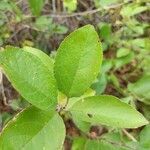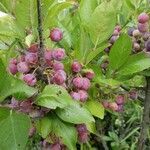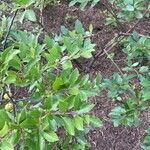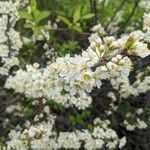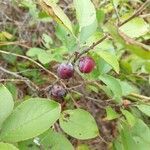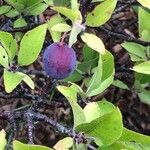Shrubs, suckering, 10–25 dm, not thorny. Twigs with axillary end buds, densely hairy to glabrate. Leaves deciduous; petiole 3–11 mm, usually densely hairy, rarely hairy only on adaxial surface, usually eglandular, sometimes glandular distally, glands 1–2, ?discoid?; blade elliptic, broadly elliptic, or obovate (orbiculate in gravesii clone), 3.5–7 × 2–4 cm, base cuneate to obtuse (rounded in gravesii clone), margins ?finely?, usually singly, rarely doubly, serrulate, teeth sharp, usually eglandular, rarely glandular, apex acute to obtuse (rounded in gravesii clone), abaxial surface usually hairy, sometimes only on veins or glabrescent, adaxial ?rugose?, glabrous. Inflorescences 2–4-flowered, umbellate fascicles. Pedicels 5–15 mm, hairy. Flowers blooming before leaf emergence; hypanthium campanulate, 2.5–3.5 mm, hairy externally; sepals erect to spreading, ovate, 1.5–3.5 mm, margins entire, sometimes 2-fid at apices, ?ciliate?, surfaces hairy; petals white, oblong-obovate, 3–8 mm; ovaries glabrous. Drupes red, yellow, dark blue, or purplish black, ?glaucous?, globose, 11–18 mm, glabrous; mesocarps fleshy; stones ovoid, slightly flattened. 2n = 16.
More
Straggling shrub 1–2.5 m, rarely arborescent and to 4 m; lvs firm, oblong or elliptic, 4–7 cm, half as wide, obtuse or acute, broadly cuneate to obtuse at base, finely serrate with broadly triangular to semicircular, abruptly acuminate teeth, rugose above, finely andrather roughly hairy beneath; pedicels 5–10 mm, finely hairy; hypanthium pubescent; sep oblong, 2.5 mm, finely hairy; pet obovate, 5–6 mm, cuneate at base; fr glaucous, purplish-black to sometimes red or yellow, subglobose, 1.5 cm; stone turgid, truncate at base; 2n=16. Dunes and sandy soil near the coast; N.B. to Md., occasionally extending some distance inland; c. Mich. May. (P. gravesii, a single unusual clone-colony in Conn., with small, subrotund lvs)
A shrub. It has a low growth habit. It grows 1.8 m high and spreads 2 m wide. The bark is dark. It loses its leaves during the year. The leaves are glossy. They are dark green but paler underneath. The flowers form a showy display. They are white and in pairs or small clusters. The fruit are 1.5 cm across. They are purple, red or yellow. They are plum-like and edible. Some kinds are very sour.
The fruit are eaten raw. They are used for jelly, jams, pies, sauces, soups, cakes, and puddings. They are also dried.
